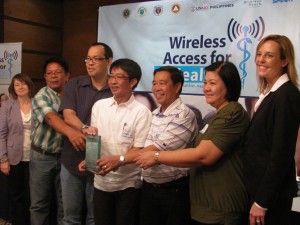
Provincial and local government officials of Tarlac with Qualcomm officials celebrate the expansion of the Wireless Access for Health project in Tarlac, providing better health services to the locals. Photo by Matikas Santos.
MANILA, Philippines – Provincial health centers in Tarlac are going wireless with the help of international mobile technology company Qualcomm Incorporated and its “Wireless Access for Health (WAH)” project with the Department of Health (DOH).
“Wireless Access for Health empowers local health care providers through enhanced patient care services and efficient patient visits using an open-source health information system,” said Crispinita Valdez, DOH’s director for Information Management System Division.
“It empowers local communities by promoting participatory health planning among local leaders, health managers and providers, thereby transforming clients and patients into partners,” she said in a statement released by Qualcomm.
The WAH project uses wireless 3G technology to improve the current Community Health Information Tracking System (CHITS), a digital medical records system developed by the University of the Philippines, Manila.
At least 21 of the 38 provincial clinics in the province of Tarlac are already implementing the WAH project since it began in 2009, Qualcomm said. The clinics are able to serve at least 1,500 patients daily.
“As of April 2012, more than 109,000 patient consultations have been captured by the system, resulting in improved patient visits and increased number of patient visits as a results of efficiencies that have reduced the four to five minutes needed to search paper records to just seconds,” Qualcomm said.
The Provincial Government of Tarlac has “committed staffing and financial resources to replicate the project in all 38 health provincial clinics, which will make Tarlac the first and only province in the Philippines to have all of its health clinics interconnected and running on a health information system,” it said,
Dr. Ricardo Ramos of the Tarlac Provincial Health Office said that “the WAH initiative is a means to deliver quality health services to clients, aid health workers, and local and national governments by promoting data-driven planning and sound decision-making.”
“Timely transmission of complete and reliable health data to local and national health agencies and government leaders facilitates policy analysis and allows faster program implementation, assisting local leaders and health workers in identifying and preventing disease outbreaks through preventive care, strategic health promotions, and advocacy campaigns,” Ramos added.
The WAH project is also aiming to expand with two other projects: the Mobile Midwife and the Synchronized Patient Alert via SMS (SPASMS) applications, Qualcomm said.
“Mobile Midwife enables data to be captured electronically during patient visits via smartphones, tablets or laptops, and instantly sends patient data to the CHITS system,” it said,
“SPASMS is an automated alert and health promotions system that sends patients information related to important health milestones such as for prenatal care and child immunizations,” it said.
There are at least 26 midwives in the pilot Mobile Midwife project while 1,100 SPASMS have been sent to 250 patients.
Mantosh Malhotra, Qualcomm Business Development Director, said that “WAH demonstrates the extraordinary benefits that 3G wireless connectivity can bring to underserved communities, particularly in the area of wireless health care.”
“We hope that what has been achieved so far will encourage the expansion of this innovative network to benefit hundreds of thousands throughout the Philippines,” he added.